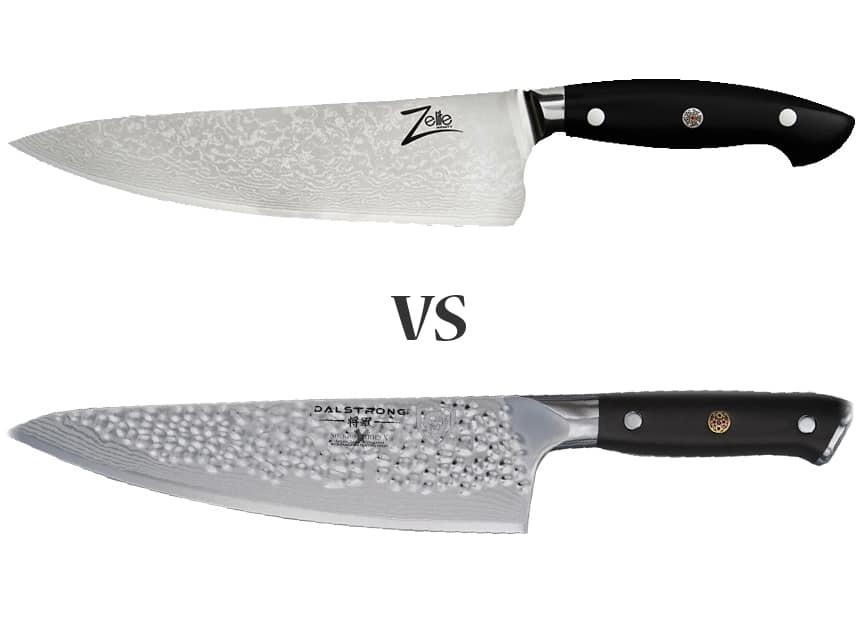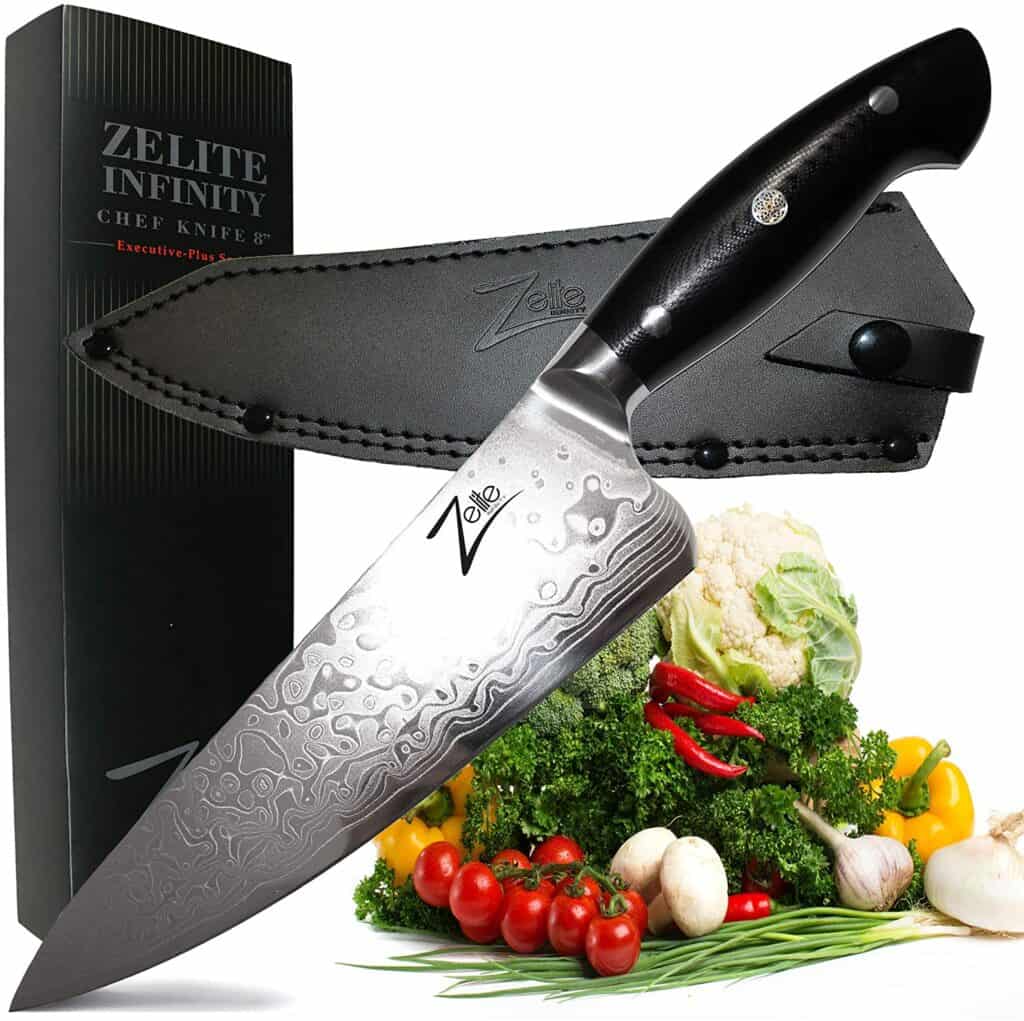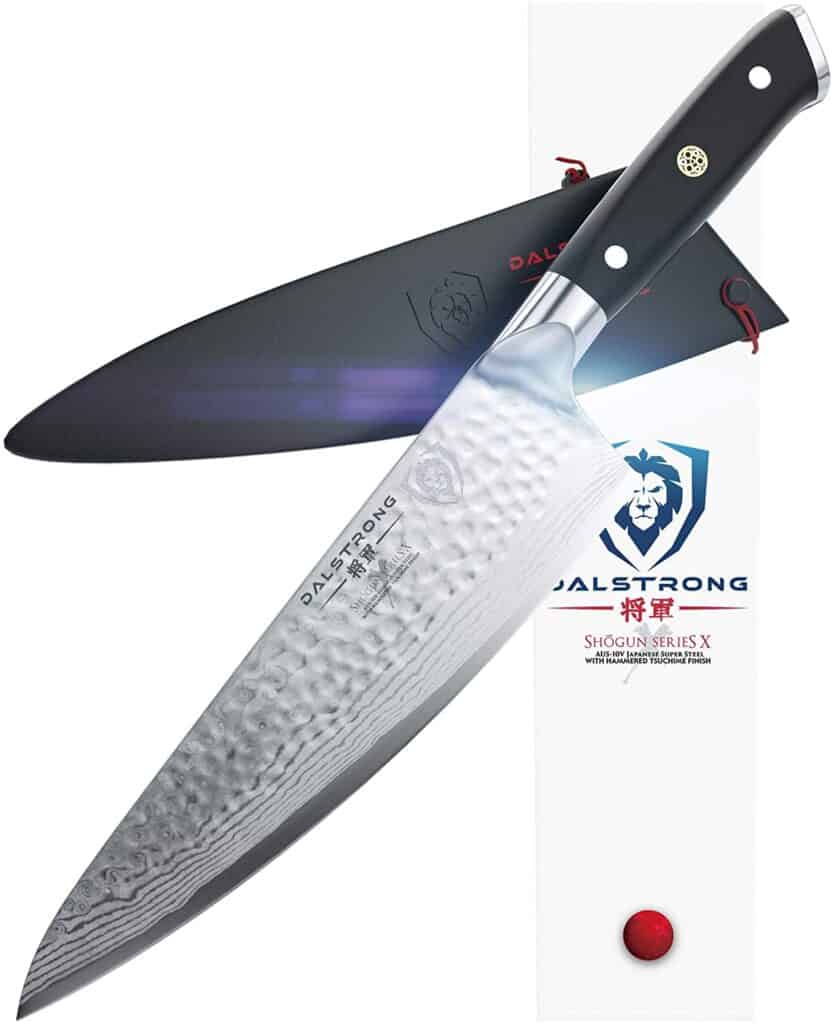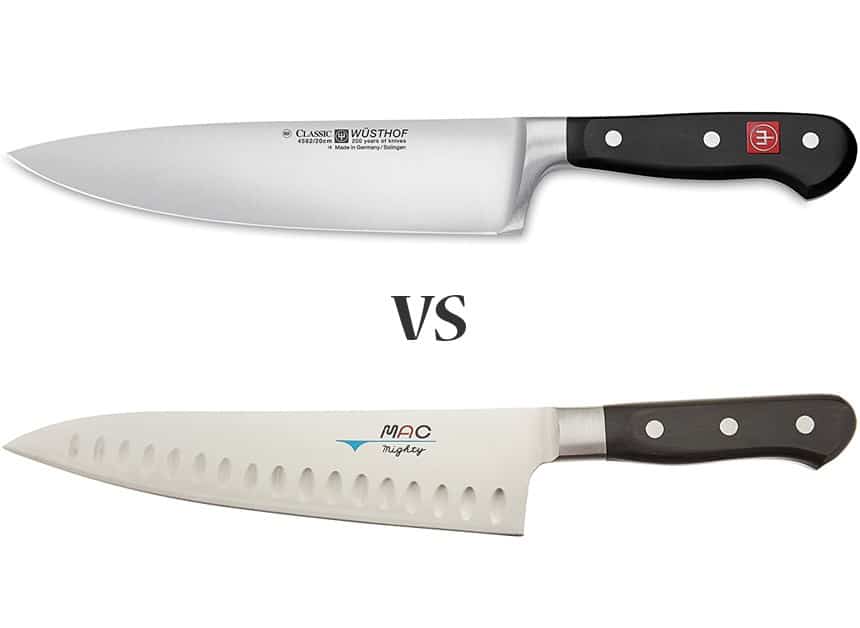
There have been a lot of Chinese brands entering the knife market in recent years.
Two in particular have drawn lots of attention due to the quality materials used are Zelite and Dalstrong.
In this article, I’m going to tell you the differences between these two Chinese brands. I’ll go in-depth into the details of each, talking about where they are made, what materials are used and the difference in price.
This should be all the information you need to select your perfect knife.
Dalstrong offers a slightly sharper blade for those knives priced above $100. For under $100 Zelite’s German-influenced knives are built with a focus on comfortable handle design and offer great value for money.
| My recommendation | Current price |
| Zelite Executive Plus 8-Inch Chef’s Knife | View on Amazon (opens new tab) |
| Dalstrong Shogun Series X Chef’s knife | View on Amazon (opens new tab) |
Zelite vs Dalstrong – Comparison Table
Here is my summary comparison table for each brand. This is mostly based on their main range of knives; the Zelite Executive Plus and the Dalstrong Shogun Series X.
For a more in-depth look at each category then check out the rest of the article below.
| Category | Zelite | Dalstrong |
| Country of Manufacture | China | China |
| Steel type | AUS-10 (other ranges use VG10 and X50CrMoV15) | AUS-10V (other ranges use AUS-8 and X50CrMoV15) |
| Rockwell hardness | HRC 61 | HRC 62 |
| Factory edge | 12 degrees (double bevel) | 12 degrees (double bevel) |
| Handle material | G10 (fiberglass laminate) | G10 (fiberglass laminate) |
| Price range | $130 – $140 (Executive Plus) | $125 – $135 (Shogun Series X) |
| Main benefit | Comfortable | Sharper |
| My recommendation | Zelite Executive Plus (view on Amazon) | Shogun Series X (view on Amazon) |
Zelite vs Dalstrong – Where are they made
| Brand | Country of manufacture |
| Zelite | China |
| Dalstrong | China |
Both Zelite and Dalstrong knives are manufactured in Yangjiang, China.
On the face of it, the fact that these knives are manufactured in China might be a little off-putting.
Let’s be honest, when we see the words ‘Made in China’ we usually think that the quality isn’t going to be great, but with Zelite and Dalstrong I think there are some large benefits from having production based there.
They still use quality materials, but as the manufacturing costs are kept low these savings are passed onto the customer.
As a result, consumers are realizing that they can get quality knives, using Japanese or German steel but for a lower price than you’d find from an authentically Japanese or German brand.
Zelite vs Dalstrong – What steel do they use
The steel used in knives will often change depending on which range you pick.
This is particularly true of Zelite and Dalstrong. They use a number of different steels throughout their ranges as they have both German and Japanese influenced knives.
Their German series both use X50CrMoV15, Zelite’s Japanese series use both AUS-10 and VG-10 depending on the range and Dalstrongs Japanese knives use AUS-10V and AUS-8.
For a fair comparison, I’m going to focus on the most popular range for both Zelite and Dalstrong knives.
For Zelite it’s their Executive Plus range and for Dalstrong it’s their Shogun Series X range.
| Brand | Steel type | Rockwell hardness |
| Zelite Executive Pro | AUS-10 | HRC 61 |
| Dalstrong Shogun Series X | AUS-10V | HRC 62 |
The Dalstrong Shogun Series X range uses Japanese steel AUS-10V. Other Dalstrong knives use X50CrMoV15 (for their German range) and AUS-8(another Japanese steel).
This is where we start to see the benefits of Dalstrong knives, the materials they use are very good quality, in this case, imported from Japan, but the Chinese manufacturing reduces the cost to the consumer.
AUS-10V is a Japanese steel with a great reputation. It’s a high carbon steel, with a Carbon content between 0.95% – 1.1%.
That means the steel is very hard, allowing it to hold a sharper edge for longer.
The Chromium level is also high at 13% – 14.5%. Again, that’s not as high as many quality western-style knives (often 15% Chromium), but it’s still enough to make AUS-10V a quality stainless steel and therefore very rust-resistant.
The Zelite Executive Plus range uses Japanese steel AUS-10. Other Zelite knives use X50CrMoV15 (for their German range) and VG-10 (another Japanese steel).
AUS-10 is a Japanese steel with a great reputation. It’s a high carbon steel, with a Carbon content between 0.95% – 1.1%.
That means the steel is very hard, allowing it to hold a sharper edge for longer.
The Chromium level is also high at 13% – 14.5%. Again, that’s not as high as many quality western-style knives (often 15% Chromium), but it’s still enough to make AUS-10V a quality stainless steel and therefore very rust-resistant.
That hardness is clearly shown in the Rockwell scale score. Both these brands have a high score, but Dalstong’s Shogun X series is slightly higher at 62 HRC compared with Zelite’s 61.
Zelite vs Dalstrong – How sharp are they
Once again I’m going to focus on the most popular knives from each brand for this comparison.
!You will experience a slightly sharper edge with the Dalstrong. The difference is quite minimal and both these knives will give you a super-sharp edge with great edge retention, but the Dalstrong slightly harder steel will result in a slightly sharper edge.
| Brand | Factory edge | Rockwell hardness |
| Zelite Executive Pro | 12 degrees (double bevel) | HRC 61 |
| Dalstrong Shogun Series X | 12 degrees (double bevel) | HRC 62 |
Sharpness is vital when looking for a knife, but in this case, there’s a bit more to it than just looking at which knife has the smallest angle of its edge.
Usually, the smaller the angle the sharper the blade. However, there are other considerations that are particularly important when comparing these two knives.
Harder knives will hold a sharper edge for longer. Both these knives use steel of similar hardness, with the Dalstrong coming out just on top.
Overall, you’re going to experience a similar, extremely sharp edge with both of these knives, but the Dalstrong will just be slightly sharper.
Zelite vs Dalstrong – What are the handles made from
The material used for handles is a vital and often overlooked feature of any knife.
A quality handle is often the sign of a quality overall knife. Handles need to be made from a durable material that can withstand all the heat and moisture fluctuations knives can experience in the kitchen.
Once again we’ll focus on the two main ranges from each brand, the Zelite Executive Pro and Dalstrong Shogun Series X.
| Brand | Handle material |
| Zelite Executive Pro | G10 (fiberglass laminate) |
| Dalstrong Shogun Series X | G10 (fiberglass laminate) |
Both Zelite and Dalstrong use a fiberglass laminate called G10 for their knife handles. Not all Zelite and Dalstrong knives use G10 but all their ranges do use good quality materials for their handles such as Pakkawood.
G10 is a fiberglass laminate, making it a fantastic material for knife handles.
It has the perfect combination of being extremely lightweight and very tough. It will be able to withstand any of the standard pressure of a kitchen.
Zelite in particular focuses quite heavily on making comfortable handles.
Both these brands use a variety of materials for their handles throughout their full range, not just G10.
But they always use quality materials, such as Pakkawood, a quality wood/resin material commonly used as a material by traditional Japanese knife manufacturers.
So whichever range of Zelite or Dalstrong knives you choose, you can be confident that the handle will be a quality, durable and comfortable one.
Zelite vs Dalstrong – How much do they cost
Both these brands have wide ranges of knives all at differing price ranges.
To allow for a fairer comparison I’ve categorized three of their major ranges that represent their highest and lowest cost knives.
I’ve tried to compare similar knives, sticking to 8 Inch Chef’s knives or the closest equivalent.
In brackets next to the general price range you’ll see the name of the range.
These prices are rough estimates. Prices do change over time but this is intended as a rough guide.
| Brand range | Zelite | Dalstrong |
| Premium | $140 – $150 (Executive-Plus Series Master) | $150 – $160 (Omega Series) |
| Standard | $130 – $140 (Executive-Plus Series) | $125 – $135 (Shogun Series X) |
| Value | $50 – $60 (Alpha-Royal German Series) | $50 – $60 (Gladiator Series) |
Both Zelite and Dalstrong clearly have quite similar price ranges for their knives.
Both price their German style knives in the lowest price range, a typical Japanese style knife from either of these brands costs upwards of $120.
The price is one of the strongest features for both these brands. If you found a genuine German or Japanese knife consisting of the same materials these two Chinese brands use, they would easily be 30%-50% more expensive than either Zelite or Dalstrong knives are.
Both these brands represent very good value for money with almost the exact same price points, so there’s nothing to choose between the two here.
Zelite vs Dalstrong – What is the difference
Now that we have looked at the design, materials, background and price of these brands we can fully understand the difference, and you should be able to make an informed decision on which knife is correct for you.
The main difference between Zelite and Dalstrong knives is that Zelite knives often focus on the comfort of the handle as a priority. Dalstrong knives tend to be a little sharper, using harder steels.
| Brand | Main benefit |
| Zelite | Comfortable handles |
| Dalstrong | Sharper |
The technical differences are quite slight, although the brands do vary in appearance quite a lot, especially for their Japanese ranges.
In terms of quality, there is not a great deal of difference between these two knives.
Zelite vs Dalstrong – Which is better for you
This really comes down to what is important to you.
There is a clear difference in the appearance of these two brands, although that is much more to do with personal taste rather than any practical difference.
Personally, I prefer the harder steel of Dalstrong knives. I find the whole point of these less expensive Japanese brands is that you can get Japanese standard materials but for a lower cost, and in general Dalstong uses the best steel.
However, if you’re looking at the german influenced ranges of these two brands, I would perhaps opt for the Zelite. They both use the same X50CrMoV15 steel so you’ll be able to get the exact same performance but Zelite places a lot of focus on the comfort of their handles which just gives them the edge on Dalstrong for their lower-priced German-style knives.
My Zelite Recommendation

View the 8-Inch Zelite Executive Plus on Amazon (opens new tab)
If you’re after the razor-sharp edge offered by Japanese steel, but don’t want to pay the cost of a Japanese manufactured knife, then the Zelite Executive Plus is a great choice.
As a comparison, the Miyabi Kaizen II 8-inch Chef’s Knife, which is a quality, Japanese knife made in Japan, uses steel of the same hardness but costs around 50% more than the Zelite Executive Plus.
The Executive Plus series in particular also has a very ergonomically designed handle, using G10 to make it very lightweight and curved to perfectly fit into the palm of your hand.
It’s a great knife, for a great price. If you’re on a budget but still looking for quality, you can go far wrong with this.
In fact, you could get the Zelite Executive Plus and a Zelite Comfort-Plus Series and still pay less than you would for one Japanese-made knife.
That way you have the best of both worlds, one super sharp Japanese steel knife and one durable German steel knife.
My Dalstrong Recommendation

View the Dalstrong Shogun Series X on Amazon (opens new tab)
My Dalstrong recommendation would be its most popular knife, the Shogun Series X Chef’s knife.
It’s a hammered Damascus finish using AUS-10V steel, incredible quality when compared with the price.
Since the steel is extremely hard this is a knife you will need to take care of. It has to be stored in a knife block or in a sheath to ensure the blade doesn’t get chipped, and it should be wiped clean and dry after every use.
But if you do that you’ll be rewarded with an incredibly sharp knife for a price that is pretty hard to beat at this price.

